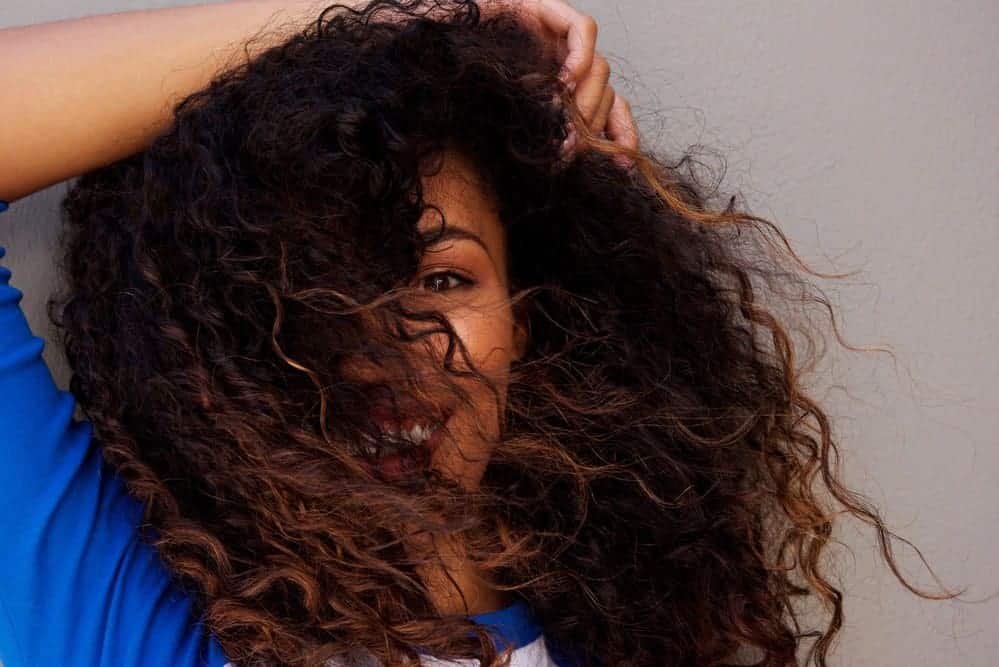
Your hair edges (also known as fragile baby hairs) are the little wispy hairs that grow around your forehead, along your hairline, and around your face. They’re short, soft, and delicate.
Unfortunately, they’re also more fragile than the rest of your hair, and they break easily. Whether you’re curious about ways to regrow edges and maintain your overall hair health, or you’re simply looking at how to grow hair edges and thinning baby hair, you’ve come to the right place.
Table of Contents
- 1 Key Takeaways: How to Grow Edges
- 2 What Causes Thin Edges?
- 3 What Can I Use to Grow My Hair Edges Back?
- 4 9 Easy Steps to Grow Back Your Thinning Hair Edges
- 4.1 1. Be Gentle with Your Hair
- 4.2 2. Keep Your Thinning Edges Moisturized and Conditioned
- 4.3 3. Avoid Tight Braids, Ponytails, and Other Hairstyles That Pull Your Edges
- 4.4 4. Avoid Hair Damage Caused by Friction
- 4.5 5. Give Yourself a Scalp Massage
- 4.6 6. Stay Healthy
- 4.7 7. Eat Foods That Promote Hair Growth and Thickness
- 4.8 8. Best Products for Thinning Edges
- 4.9 9. Be Patient
- 4.10 Related Articles
- 5 Frequently Asked Questions
- 5.1 How Can I Get My Edges to Grow Back?
- 5.2 How Long Does It Take to Regrow Edges?
- 5.3 How Do I Control My Natural Hair Edges?
- 5.4 Is Laying Your Edges Bad for Your Hair?
- 5.5 Does Virgin Hair Fertilizer Grow Edges?
- 5.6 Why Am I Losing Hair on My Edges?
- 5.7 How Do You Fix Damaged Hair Edges?
- 5.8 Are Edges Permanently Damaged?
- 5.9 Can Minoxidil Regrow Edges?
- 5.10 Final Thoughts on How to Grow Edges Back
Key Takeaways: How to Grow Edges
- Be Gentle with Your Hair: When washing, styling, and handling your hair, always be gentle. Take extra precautions around the hairline. Avoid aggressive scrubbing or pulling, which can cause damage to your edges.
- Stop Wearing Tight Hairstyles: Fragile hair strands can suffer from constant tension. Opt for looser styles to maintain healthy edges. Embrace protective styles and aim to reduce habits like hand-in-hair syndrome. Treat your edges with the utmost care.
- Female Pattern Hair Loss: Hormonal changes can make your hair thin and edges fragile.
- Essential Oils and Carrier Oils: Boost blood flow to your fragile edges using hair oils. You can use a mix of essential oils diluted with a carrier oil. This promotes healthier hair strands and rejuvenation.
- Proper Glue Remover: When wearing wigs, always use a proper glue remover. Otherwise, you could further damage your already fragile edges.
- Satin: Sleep with a satin pillowcase or scarf to reduce friction on your edges. Satin will help prevent dry hair and protect your hair edges.
What Causes Thin Edges?
Various conditions can increase the likelihood of hair loss, including pregnancy, postpartum hair loss, stress, sudden weight loss, thyroid problems, anemia, hormonal imbalances, and certain scalp conditions like seborrheic dermatitis or alopecia areata.
Also, hairstyles that place too much tension on the hair, such as braids, weaves, or tight ponytails, can lead to thinning edges.
In some cases, hair loss can also be hereditary. It's essential to identify the root cause of thin edges to determine the appropriate treatment, whether it be through lifestyle changes, medication, or a visit to a dermatologist or hair specialist.

If you want to learn more about hair loss causes and treatment options or the best shampoos for hair loss, we've written comprehensive articles on those topics.
If you’re concerned about an underlying health condition or you can’t determine the cause of sudden or dramatic hair loss, be sure to reach out to your doctor or seek professional medical advice.
You're not alone in your journey.
According to the American Hair Loss Association, women make up 40% of Americans suffering from hair loss, and many feel embarrassed or upset (source).
It’s important to stay positive. Remember that you’re not alone. While healthy hair is a worthwhile pursuit, you’re beautiful either way.

What Can I Use to Grow My Hair Edges Back?
There are several steps you can take to grow back your hair edges. Firstly, be gentle with your natural hair and avoid scrubbing, scratching, or pulling your hair too tight, especially around your hairline.
Incorporate protective styles into your hair care regimen and avoid tight hairstyles like braids, weaves, and ponytails that pull on your edges. Keep your edges moisturized and conditioned with regular deep conditioning treatments, and use a heat protectant when using heating tools.
Avoid hair damage caused by friction from hats, headbands, and rough fabrics by wearing silk or satin scarves. Give yourself a scalp massage with oils like Jamaican black castor oil.
Stay healthy by eating foods that promote hair growth and thickness, and be patient as hair growth takes time. Lastly, avoid product hype and be gentle with your edges, using gentle hair products like Miss Jessie’s Curly Butter Crème, Carol’s Daughter’s Coco Crème, and SheaMoisture Jamaican Black Castor Oil Strength, Grow, & Restore.

9 Easy Steps to Grow Back Your Thinning Hair Edges
Don’t blame yourself for having thinning or damaged edges. Lots of women will experience the problem at some point in their lives.
Even if you’re doing everything right, your edges can still give you trouble.
That said, taking good care of your hair and adjusting a few key aspects of your hair care routine can help, so we’ve put together a list of ideas to get you started.
1. Be Gentle with Your Hair
When washing, styling, and handling your hair, be gentle, especially around your hairline. Scrubbing, scratching, or pulling your hair too tight can easily damage your edges. Instead, incorporate protective styles into your hair care regimen.
Read this article to learn more about the concept of protective styling.
If you find yourself absentmindedly pulling or twisting your hair, do your best to break the habit (i.e., hand-in-hair syndrome). If you have hand-in hair syndrome, see how long you can go without touching your hair.
The goal is to keep your hands out of your hair as much as possible. Treat your edges with patience and care, like a little garden you’re growing on your head.

2. Keep Your Thinning Edges Moisturized and Conditioned
There is a reason why people often refer to their hair edges as their "remaining baby hair", and it's partly because the hair around your edges often has a different texture or curl pattern than the remainder of the hair on your head.
Because of these differences in hair textures, you may need to consider creating a "customized" unique regimen for your edges, especially if you're experiencing breakage along your edges.
It could be caused by improper moisturizing and conditioning.
Your edges are delicate, and unless your hair is covered, they're almost always exposed to environmental elements. So, it's important to ensure your edges are regularly moisturized and conditioned.
As we've mentioned, your edges are already fragile, but they’re especially likely to break when your hair is dry.
We recommend that you incorporate a deep conditioning process in your hair care regimen, moisturize regularly, and limit the use of heat on your hair to help prevent heat damage.
If you need to use a hair dryer, flat iron, or other heating tools, always use a heat protectant on your hair and use the lowest temperature possible to produce your desired results.
Heat styling tools can be damaging to your hair, and it's important to learn what you can do to stop your hair from breaking and shedding.
For more information and tips on finding the right moisturizer, revisit our previous article on how to avoid hair breakage.

3. Avoid Tight Braids, Ponytails, and Other Hairstyles That Pull Your Edges
Buns, twists, braids, and ponytails can pull on your edges, damaging these baby hairs or stretching them to the point of breaking.
Consider limiting how much you pull your hair back, and when you do, consider a looser look when possible. The tighter the hairstyle, the more it will pull on your edges, potentially leading to damage and breakage.
If you decide to get extensions, ask your stylist to avoid your edges or treat them with extra care.
During the installation process, you should notify your stylist if you experience any pain. Notifying them quickly allows them to make adjustments to the style before it's finished.
Likewise, if you continue to experience pain more than twenty-four hours after installation, we recommend removing the braids. This prolonged discomfort is a warning signal from your body, communicating that something is wrong.
Here are some examples of hairstyles, treatments, hair tools, and techniques that can cause physical trauma to your hairline (i.e., hair edges):
- braids, weaves, sew-ins, and other styles that pull the hairline tightly or place additional weight on the hairline (e.g., heavy braids)
- combs or hair picks that aren't used gently can damage your edges. For example, if you often wear hair buns and use a comb to make your bun neat around your edges, you must be gentle. We don't recommend styling your hair while you are in a rush, for instance, while you're running late for work.
- overlapping damaging chemical treatments, like coloring treatments, relaxers, and texturizers, are very damaging to your hair.
If your edges are thinning, we recommend discontinuing processes that can potentially cause physical trauma to your hairline.
While eliminating tight hairstyles is often an easy step towards growing back your edges, it's also important to note that wigs have the potential to damage your thinning edges, too.
The constant rubbing (i.e., "friction") often caused by wearing a wig can cause your edges to rub away.

4. Avoid Hair Damage Caused by Friction
You might be tempted to cover up thinning or missing edges, but it’s important to let them breathe when possible.
If you want to wear hats or headbands, try to find ones with silk linings. Alternatively, wear silk or satin scarves between your hat and your hair.
This will protect your edges from the friction of rougher materials.
Similarly, you can wrap your hair with a silk scarf at night. Silk will help to protect your hair, whereas other types of fabric may absorb the moisture and natural oils from your hair.
It’s probably worth investing in silk pillowcases to avoid the harsh friction between your hair and cotton pillowcases, which can break and dry out your hair.

5. Give Yourself a Scalp Massage
Although, in most cases, it’s best to avoid any contact with your edges, you can make exceptions for the occasional scalp massage.
Slow, gentle rubbing will stimulate hair growth by increasing blood circulation to your scalp and boosting circulation, bringing oxygen to your hair follicles.
Using oils when you do this comes with the added perks of moisturizing, strengthening, and adding a protective layer to your edges.
Some of our favorite hair oils are Jamaican black castor oil, rosemary oil, peppermint oil, jojoba oil, and coconut oil.
6. Stay Healthy
It's essential to consider your overall health. Generally speaking, it's easier to improve the health of your hair if you're also taking care of your body.
Be sure that you eat a balanced diet, including an ample amount of vitamins and nutrients, and take a multivitamin daily.
If you’re interested in experimenting with supplements, consider talking to your doctor about the pros and cons of biotin and other hair vitamins.
Experts have mixed opinions on the effectiveness of these treatments, but many women swear by these methods.
Regardless, do your best to maintain a strong, hydrated, healthy body, and you’ll see improvements in your hair, including your edges.
7. Eat Foods That Promote Hair Growth and Thickness
Meats like steak and chicken, oysters, seeds, shrimp, fatty fish, eggs, beans, avocados, soybeans, nuts, sweet peppers, spinach, sweet potatoes, and berries are foods that we recommend for encouraging hair growth and thickness.
Learn more about the best foods for hair growth and thickness with this article.

8. Best Products for Thinning Edges
Regardless of what you might hear during television commercials or read on the product packaging for some hair products, you don't need to purchase any "special" products designed specifically to grow your edges back.
The same shampoos, conditioners, oils, and moisturizers designed for other parts of your hair can also be applied to your hairline.
We believe it's best to be gentle with your edges. Don't pull them, brush them daily, or constantly use gel or Vaseline to lay your edges down.
If you're looking for a few gentle hair products, these are a few that we recommend:
- Miss Jessie's Curly Butter Crème
- Carol's Daughter's Coco Crème
- SheaMoisture Jamaican Black Castor Oil Strength, Grow, & Restore
I also recommend keeping facial cleansers and makeup removal creams away from your hairline, as these products can potentially cause damage to your edges.
For example, if you're using an acne facial wash, it may advise that the product doesn't contact your hairline. Be sure to read the directions on the product packaging.

9. Be Patient
The reality is that hair growth takes time. Studies show that an average person will grow ½ inch of hair monthly and up to six inches yearly.
Assuming that these estimates are accurate (for you), there's no substitute for patience. Hair growth takes time. The concepts, techniques, and advice in this article are provided to help encourage and enhance the hair growth process, but keep in mind that it will take time.
- How to Tame Baby Hairs White Girl
- Black Girl Messy Bun Hairstyles
- Best Hairstyle to Sleep in for Hair Growth
- Does Dyson Airwrap Damage Hair?
Frequently Asked Questions
Are you navigating the journey to regrowing hair edges? Here are some frequently asked questions and answers to help address your concerns.
How Can I Get My Edges to Grow Back?
To promote the growth of your hair edges, avoid tight hairstyles that cause tension. Examples include ponytails or braids. Apply nourishing hair oils or creams to your edges. Consider using products with ingredients like peppermint or castor oil. Regularly massage your edges to improve blood circulation. For advanced solutions, consider consulting a dermatologist or trichologist.
How Long Does It Take to Regrow Edges?
The time it takes to regrow edges varies among individuals. With proper care and treatment, many people start to see hair growth within 3-6 months. Genetics, health, and the original cause of the hair loss affect growth rate.
How Do I Control My Natural Hair Edges?
To control hair edges, it is important to maintain moisture, avoid tight hairstyles, protect the hairline at night, and use edge control products. Edge control products can help lay down your edges while providing nourishment and moisture to the hairline. Look for natural ingredients, such as aloe vera or shea butter, and avoid using products with harsh chemicals.
Is Laying Your Edges Bad for Your Hair?
Laying your edges is not necessarily bad for your hair, but it can be if done too frequently or with harsh products. Using edge control products with harsh chemicals, such as alcohol or petroleum, can cause hair breakage and damage the hairline. Additionally, pulling your hair too tightly or often into a slicked-back style can damage your edges.
Does Virgin Hair Fertilizer Grow Edges?
While Virgin Hair Fertilizer may help to nourish and strengthen hair, there is no scientific evidence to suggest that it specifically targets the growth of edges or hair along the hairline. The ability of any hair product to stimulate hair growth depends on many factors, including genetics, health, and hair care practices.
Why Am I Losing Hair on My Edges?
Hair loss on the edges can be caused by factors such as excessive tension on the hair (traction alopecia), hormonal imbalances, nutritional deficiencies, harsh hairstyling practices, or medical conditions. Identifying the underlying cause is important to prevent further hair loss, and seeking medical or professional advice can help determine the best course of action for treatment and prevention.
How Do You Fix Damaged Hair Edges?
To fix damaged hair edges, it is essential to moisturize, avoid tight hairstyles, protect at night, use natural edge growth products, be gentle, and address underlying health issues. Fixing damaged hair edges is a process that requires consistency and patience. By maintaining healthy hair practices and using the right products, you can restore the health of your hairline over time.
Are Edges Permanently Damaged?
Edges can be permanently damaged if there's repeated trauma to the hair follicles. This condition is known as traction alopecia. If the damage isn't severe and your hair follicles are still healthy, your hair can grow back. You'll need to use a regimen with proper care and treatment.
Can Minoxidil Regrow Edges?
Yes, minoxidil is an FDA-approved topical treatment for hair loss. It has shown efficacy in promoting hair regrowth, including growing edges. However, it's essential to consult with a healthcare professional before using minoxidil.
Final Thoughts on How to Grow Edges Back
Thinning edges and the fear of continued hair loss can be a traumatic experience, especially if you're not sure how you can regrow your edges.
Just remember that wearing tight hairstyles, like ponytails, box braids, and other styles that pull on the hairline, is often the cause of issues with a thinning hairline, edges thinning, or breakage along the hairline.
It's critical that you keep these hair care tips in mind when you get your hair braided. Use preventative measures to ensure that you're correctly moisturizing and conditioning your hair without introducing unnecessary trauma.




